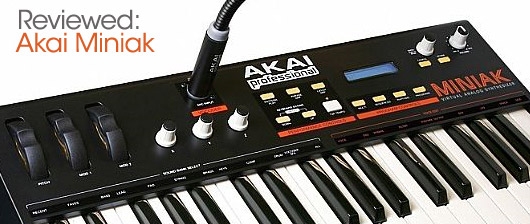DJ & Studio Equipment: Akai Miniak review
This week Juno Plus’ Ben Daly takes a closer look at one of Akai Professional’s latest offerings, the Miniak virtual analog synthesizer.
On first impression, the Miniak is a well-built, robust looking synth with a clutter-free layout and minimal controls. Its compact size and manageable weight makes it ideal for musicians and performers to transport to and from gigs. The 37 semi-weighted keys have a nice action to them and are also velocity sensitive. Meanwhile the pitch and two modulation wheels are attractively backlit in orange, have a smooth tactility when moved and a rubberised finish for a non-slip grip. All the other buttons (bar one) are backlit in either orange or red and have a re-assuring click to them when pressed.
The keyboard octave buttons glow incrementally darker the further you move up or down the octaves, which is a thoughtful addition from Akai, and at a glance you can see how many octaves the keyboard has been transposed by. The other five controls are rotary; three of which are endless parameter knobs (X, Y and Z), one a master volume knob and the other a data push-knob which clicks when twisted round and acts as a button when pressed. You’ll also find a small LCD display with a blue backlight and an XLR connector that the included gooseneck vocoder microphone clicks into. The gooseneck microphone is rugged and should withstand all manner of knocks and scrapes, which can also be said for the other controls and indeed the Miniak in general.
“The Miniak is a wonderful synth which has a very deep and complex architecture. Spending time to get to know this piece of equipment will bring great reward to the user as it is capable of so much, most of which is hidden deep within the menus”
Switching on the Miniak, it’s immediately noticeable how difficult it is to read the text on the LCD display while sat down. This is because the angle of the screen sits flat against the keyboard. Standing up remedies the problem though, so shouldn’t be an issue for live use. Another issue with the LCD display is its size. Being so small makes editing sounds slightly tricky as it involves clicking through various pages to make changes.
Minor gripes aside, the Miniak has a fantastic collection of sounds which are conveniently divided up into nine different program categories; Bass (79), Lead (61), Pad (140), String (24), Brass (25), Keys (39), Comp (130), Drum (121) and Vocoder/SFX (68). Many of the classic analog synthesis sounds can be found on the Miniak which makes it a definite go-to synth you’ll use time and time again. In fact the Miniak has more than 600 presets built-in so you’re sure to find something suitable. Users can also create their own presets or edit the available ones for greater flexibility.
The 40-band vocoder on the Miniak is a great tool which is capable of creating all the classic robot voice sounds as well as some interesting sound effects that would be perfect for soundscapes or glitchy music.
The Miniak features 320 different rhythms which can be played as loops (with the left half of the keyboard) or as the individual hits which make up the loop (on the right half of the keyboard). The loops are perfect for live performances while the individual hits are a quick and easy option to go to in the studio.
The Phrase Arp feature of the Miniak is a nice quirky addition that allows you to record phrases (chords, melodies, loops etc.) and play them back in any key signature by holding down a key on the keyboard. These phrases can also be played back at any tempo by shifting the tempo up or down or by pressing the tap tempo button.
The Miniak features a powerful pattern sequencer that plays back melodic figures when triggered by the keyboard. This creates intricate arpeggios that spice up sounds nicely with a rhythmic melody.
“The 40-band vocoder on the Miniak is a great tool which is capable of creating all the classic robot voice sounds as well as some interesting sound effects that would be perfect for soundscapes or glitchy music”
The Miniak also features a multi setting, which is the most powerful part of the synth and is a combination of programs, sequences and rhythms. Together these make for lush soundscapes, intricate rhythmic and sonic textures and sophisticated keyboard splits.
Specification-wise, the Miniak has eight voices each with three oscillators, stereo effects, two multimode filters, three envelope generators, two LFOs, dynamic real-time and step sequencers, an arpeggiator, and a drum machine/rhythm sequencer. The Miniak also features 24-bit 1/4″ balanced stereo analog outputs and inputs.
The Miniak is a wonderful synth which has a very deep and complex architecture. Spending time to get to know this piece of equipment will bring great reward to the user as it is capable of so much, most of which is hidden deep within the menus. As a performance tool the Miniak shines as its presets are great straight out of the box and its simple layout and quick access to sounds will save precious time while on stage.
Words: Ben Daly

